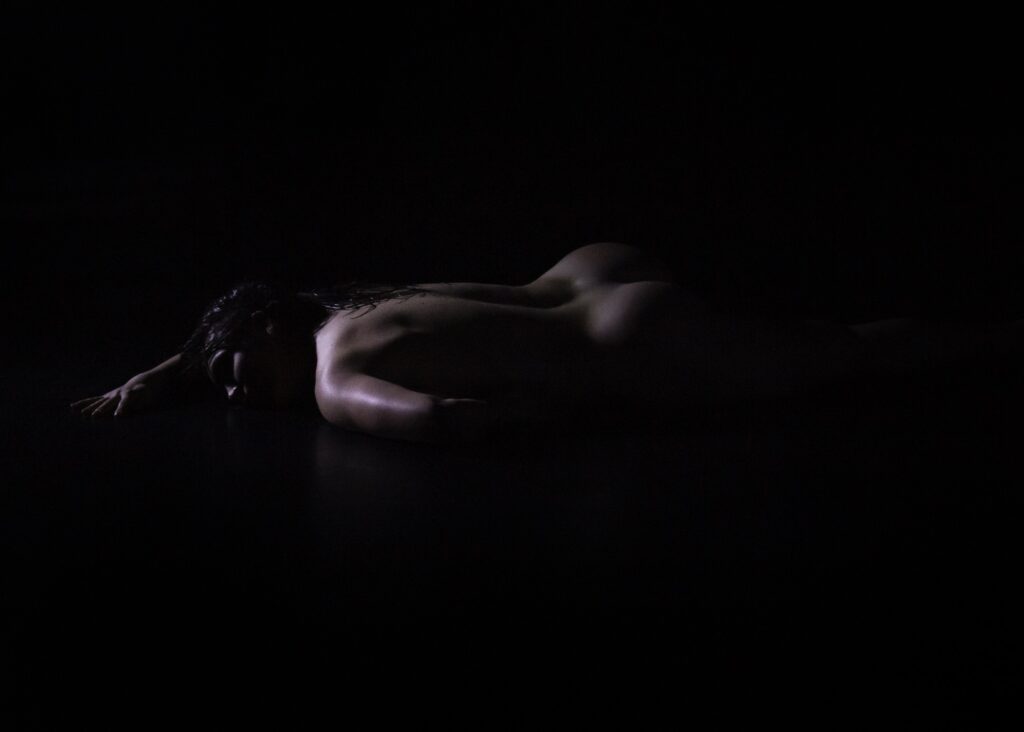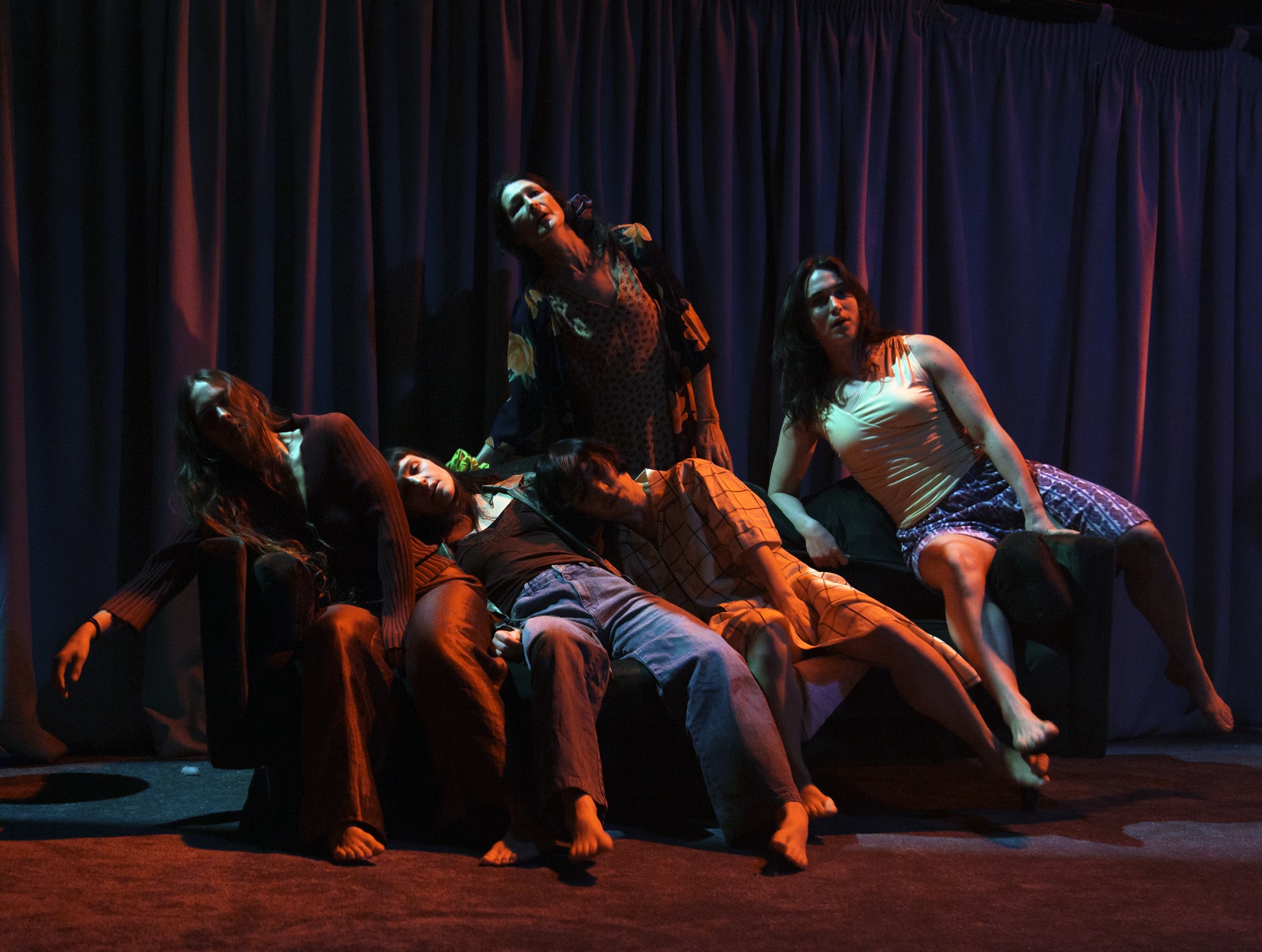Words by Francesca Matthys.
More than a week later and The Heat by Becky Namgauds is still etched in my mind like a static TV, buzzing continuously. This surreal new dance theatre work made me laugh, hold my breath, clutch onto my seat and release my breath in relief. The Heat is real, and explores the desires and feelings that we repress as women living in this bizarre world. In 2025, it is very relatable.
Set design plays a large role in the creation of this surreal world that Namgauds and collaborators birth us into. A sheet of plastic conceals a domestic abode, like an amniotic sac holding a fetus. As the emotive preset music begins to dissolve, our safety sac soon evolves to what looks like a suffocating performer within it. Perhaps it’s an early reference to the violence imposed on female bodies, disposable bodies or simply the suffocation of our domestic lives.
As a bare body crawls into frame using inverted and contorted movement, I am reminded of the 2024 feminist horror hit ‘The Substance’ that addresses aging in the 21st century, as a woman in the public eye. The Heat, perhaps inadvertently, references other cult classics such as ‘Death Becomes Her’ with headless bodies and ‘Get Out’ with its stark reference to sinister other worlds, that take both a surreal and dreamlike approach to representing the human experience (a reflection of Namgauds’ interdisciplinary practice as a dance maker). In an interview with South East Dance – and where I watched the performance – Becky shares other inspirations for the work that include the series ‘Dog Woman’ by visual artist Paula Rego and psychologically charged domestic images by Gregory Crewdson.
Alongside its rich and potent images, the movement vocabulary of The Heat is gritty, pleasantly peculiar and primal. After very delicately and meticulously consuming tomatoes with chopsticks, Masumi Saito crouches on a coffee table in an ‘unruly’ fashion, demolishing what is left of her feast. This energy ripples through the rest of the collective as the collective all break into intense gestures and movements, implying connotations of auto-erotisim and being in labour even. To be frank, this was one of my favourite moments of the work, a cathartic release of some sorts, a yearning, an urge, a need that audience members could relate to.
As women our very nature of sensuality, gentleness and rage amongst other things is so often suppressed, the root of these integral expressions can be located through the lower chakras and this amplified expression of sexuality feels like a culmination of these experiences. Allowing us as audience members to feel its effects too.
This work is imbued with moments of collective feeling, processing and care that truly resonate with our current reality as women. As the collective breaks apart from their solos, duets or trios, it is the couch that unites them together (the only place they truly move together as a full collective). I wondered about the meaning of this couch; the obvious connotations of the couch as a symbol of therapy in Western society came to mind and ironically is a symbol for this dismantled form of purging our emotions. A space that holds the processing, the stories, the feelings.
They fix, clean, they wait, they care, they obsess about their appearances and clean again all in the spirit of ‘girlhood’; a term coined on TikTok in recent times and a departure from frequently used ‘girl boss’ or ‘girl power’. Reflecting on the nuanced and shared experiences of womanhood that are often hyper feminine yet mundane and everyday.
Another reference to the everyday could be a duet by Becky Namgauds and Bonni Bogya that displays a moment of meeting oneself, or a version thereof, and develops into an oozing into one another, almost becoming one. Their costume choice here is a rich maroon, that can obviously in this context, be associated with menstrual blood, birthing blood and the blood of women under the hands of femicide and domestic violence. Their duet reminded me of how as a woman, throughout my life, I have spent so much time dissecting my appearance in the mirror, acquainting myself with it, for better or worse. Caroline Reece extends this throughout the work by looking at themselves in a compact mirror and donning exaggerated magazine cutouts of lips, as life goes by in front of her. To us, our femininity is perhaps a distorted hallucination…
The reflection of a window fades in and on the couch Reece continues to dissect and obsesses in her compact mirror as the other four dancers journey together. Reece watches perhaps in nostalgia for memories once shared and roads once taken. Once again the couch becomes a signifier for the multitude of experiences we may journey through as women, becoming Alice’s rabbit hole that she almost gets sucked into. The sunken place.
Towards the end of the work, the carpet (another scenic device) wraps up the entire disarranged set and performers in it as if to conceal the experiences of womanhood, as society does.

The final moments of the work draw us into a darker lit space where the naked bodies of performers can be seen vaguely and slowly traversing the space. I am often skeptical of nudity on stage and often question the intention of it (however artists can of course do what they choose). The Heat however offers and uses nudity as a signifier for either rebirth or a pure place of origin where we have shed any baggage of our earthly bodies and can exist within the realm of sense and breath.
The Heat is truly an emotional experience that roots our perspectives on self and womanhood, offering a window into a range of personal landscapes of these experiences.
The work was shared as part of South East Dance’s ‘Undisciplined Festival’ in Brighton and will have its London debut at the Lilian Baylis Studio at Sadler’s Wells from 22-23 May 2025. Header image by Pari Naderi and featuring dancers Bea C. Bidault, Becky Namgauds, Bonni Bogya, Caroline Reece, Masumi Saito.
